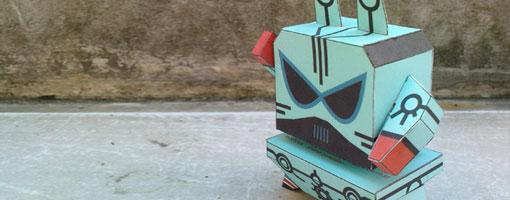- Details
- Written by: Julius Perdana
- Category: Simple Papercraft

A very cute papercraft, design by Dhendiawan Dwiatma a newcomer papertoy designer from Indonesia. This model is his very own character design. Beside Dimzee there are also Pingoo and Squee. He named these characters Paperonizalia Heroes!
- Details
- Written by: Julius Perdana
- Category: Simple Papercraft

The term Greys denotes a style of alleged intelligent, humanoid, extraterrestrials appearing in folklore, popular culture, and the pseudoscience of ufology. In particular, they are a common motif in close encounter and alien abduction claims. In abduction claims and popular culture, several commonalities of appearance tend to typify "Greys."
They are typically depicted as gray-skinned diminutive humanoid beings that possess reduced forms of or outright lack human organs and anatomical components. Their bodies are usually depicted as elongated, small chested, and lacking in muscular definition and visible skeletal structure. Their legs are shorter and jointed differently than one would expect in a human. Their limbs are often depicted as proportionally different than a human's; their humerus and thighs are the same lengths as their fore-arms and shins, respectively. They may have 3-5 fingers and may be depicted as lacking opposable thumbs. [Wikipedia]
- Details
- Written by: Julius Perdana
- Category: Simple Papercraft

Anubis is the Egyptian name for a jackal-headed god associated with mummification and the afterlife in Egyptian mythology. In the ancient Greek language, Anubis is known as Inpu, (variously spelled Anupu, Ienpw etc.). The oldest known mention of Anubis is in the Old Kingdom pyramid texts, where he is associated with the burial of the king. At this time, Anubis was the most important god of the Dead but he was replaced during the Middle Kingdom by Osiris.
He takes various names in connection with his funerary role, such as He who is upon his mountain, which underscores his importance as a protector of the deceased and their tombs, and the title He who is in the place of embalming, associating him with the process of mummification. Like many ancient Egyptian deities, Anubis assumes different roles in various contexts, and no public procession in Egypt would be conducted without an Anubis to march at the head. [Wikipedia]
- Details
- Written by: Julius Perdana
- Category: Simple Papercraft

Horus is one of the oldest and most significant of the deities in the Ancient Egyptian religion who was worshipped from at least the late Predynastic period through to Greco-Roman times. Different forms of Horuses are recorded in history and these are treated as distinct gods by Egyptologists.These various forms may possibly be different perceptions of the same multi-layered deity in which certain attributes or syncretic relationships are emphasised, not nescessarly in opposition but complemenary to one another, consistent with how the Ancient Egyptians viewed the multiple facets of reality.The earliest recorded form is Horus the Falcon who was the patron deity of Nekhen in Upper Egypt and who is the first known national god, specifically related to the king who in time became to be regarded as a manifestation of Horus in life and Osiris in death. The most commonly encountered family relationship describes Horus as the son of Isis and Osiris but in another tradition Hathor is regarded as his mother and sometimes as his wife. [Wikipedia]
